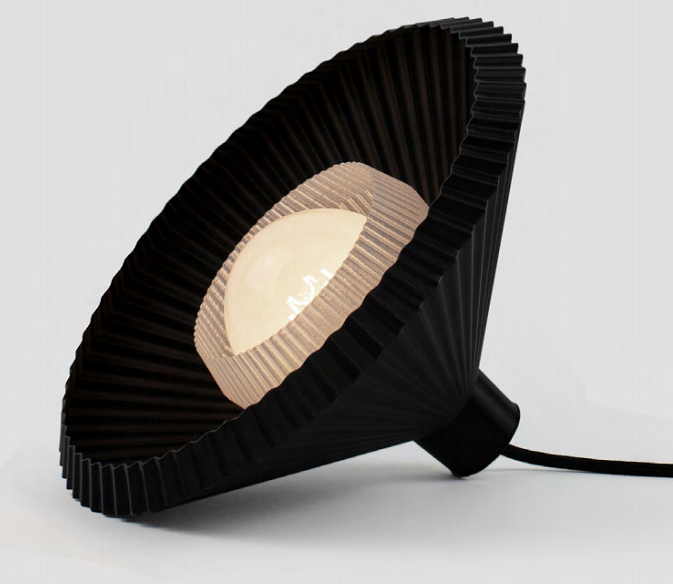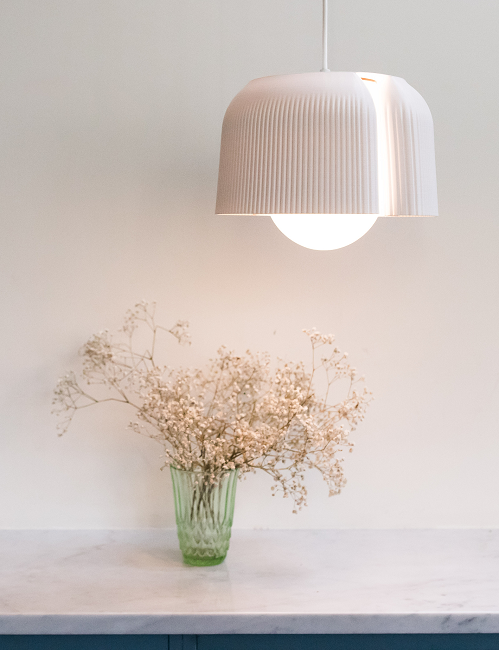3D printing has obviously done a lot of good in many of the major sectors of the world, like aerospace and medical. But, every once in a while, Plumen sneaks in to remind me that the technology is just as useful in the consumer goods market…and can also be just as sustainable.
 The designer low energy lighting company, founded nearly a decade ago by Nicolas Roope and Michael-George Hemus, believes that the way to get people on board with energy efficient lighting is by providing them with attractive low energy light bulbs, and all the sustainable accessories that go with them, like lampshades.
The designer low energy lighting company, founded nearly a decade ago by Nicolas Roope and Michael-George Hemus, believes that the way to get people on board with energy efficient lighting is by providing them with attractive low energy light bulbs, and all the sustainable accessories that go with them, like lampshades.
Now, Plumen is collaborating with London-based design company Batch.works on a new range of lampshades, 3D printed out of recycled plastic from waste items like water bottles.
 “When we first met Batch.works, it seemed like the perfect match. We’re both small businesses with a similar ethos and approach to things. The fact that you can use recycled plastics and they can then be industrially biodegraded or reused again is really fascinating to me, and plays into the circular economy – which we are trying to put into practice everywhere we can,” said Plumen co-founder Hemus.
“When we first met Batch.works, it seemed like the perfect match. We’re both small businesses with a similar ethos and approach to things. The fact that you can use recycled plastics and they can then be industrially biodegraded or reused again is really fascinating to me, and plays into the circular economy – which we are trying to put into practice everywhere we can,” said Plumen co-founder Hemus.
“To Plumen, 3D-printing is a very exciting opportunity for lighting. 3D-printing allows shapes and forms that are not possible otherwise. More importantly, there is very little waste compared to traditional methods – products are made to order, from recycled plastic bottles and at the end of their lives they can be recycled once again. It’s a sustainable vision for the future.”

The collection’s first two 3D printed shades, Neo by Matthias Lauche and Ribbon by BOLD, were recently released, and are available to purchase from the online stores of both Plumen and Batch.works; more lampshades will be released in 2020.
 Neo, based on geometric Art Deco forms, is for Plumen’s Milky Willow bulb, and features two shades stacked one on top of the other in order to frame the Plumen E27 pendant light. Because there are two parts to the Neo shade, it can be created in multiple color combinations.
Neo, based on geometric Art Deco forms, is for Plumen’s Milky Willow bulb, and features two shades stacked one on top of the other in order to frame the Plumen E27 pendant light. Because there are two parts to the Neo shade, it can be created in multiple color combinations.
The Ribbon shade has a more fluid surface, thanks to the capabilities of 3D printing, and bends over itself to, as Plumen explained in a press release, “surround and protect” its Milky Wilma bulb.
“The space created by the shade is filled with light, revealing and emphasising the different volumes created by the enveloping surface,” the release continues. “The vertical lines that run through the shade, combined with the horizontal layers that are characteristic of this manufacturing technique, amplify the appearance of a piece of textile that’s solidified around the light – directing it and enhancing it. Light peeks through the shade’s open space, allowing the iconic bulb to be seen from another angle.”
 As part of the companies’ continuing commitment to reduce and reuse plastic, each of the 3D printed lampshades is fully recyclable. The shades are all made at Batch.works’ east London headquarters, as the company is also committed to local manufacturing, and are printed on-demand using filament from Amsterdam-based social enterprise Reflow, which also re-purposes plastics that would otherwise be wasted. Additionally, the shades can also be returned to Batch.works for recycling once they’ve reached the end of their lifespan.
As part of the companies’ continuing commitment to reduce and reuse plastic, each of the 3D printed lampshades is fully recyclable. The shades are all made at Batch.works’ east London headquarters, as the company is also committed to local manufacturing, and are printed on-demand using filament from Amsterdam-based social enterprise Reflow, which also re-purposes plastics that would otherwise be wasted. Additionally, the shades can also be returned to Batch.works for recycling once they’ve reached the end of their lifespan.
“We believe that thinking more carefully about what materials are used, and how things are produced, is key to combating short-termism. That’s why this kind of collaboration is so promising. We believe 3D printing can be scaled to a wider variety of products, and become a practical manufacturing method for the future – and that’s what we want to achieve,” stated former architect Julien Vaissieres, who founded Batch.works in 2016 with a goal of making eco-friendly, affordable 3D printed products.

Batch.works created the Plumen lampshade collection with the help of five different design studios. Black and white are the currently the only available colors, though you can request custom ones, dependent on volume. The 3D printed Neo shade is £149, while the Ribbon is £199…a lot more than I’d typically spend on a lampshade, really, but I love that they are completely sustainable.
Discuss this story and other 3D printing topics at 3DPrintBoard.com or share your thoughts in the Facebook comments below.
[Images provided by Urban Alps]
The post Plumen & Batch.Works: 3D Printed Lampshade Collection Made from Recycled Plastic appeared first on 3DPrint.com | The Voice of 3D Printing / Additive Manufacturing.









